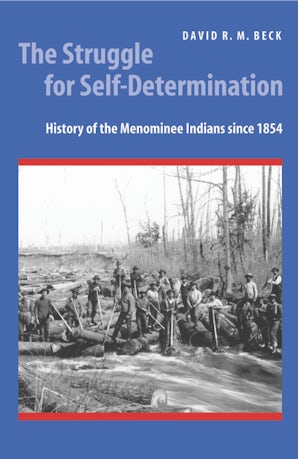The Shoshone-Bannocks: Culture and Commerce at Fort Hall, 1870–1940. By John W. Heaton. (Lawrence: University Press of Kansas, 2005. x, 340 pp. $39.95, ISBN 0-7006-1402-8.)
The Struggle for Self-Determination: History of the Menominee Indians since 1854. By David R. M. Beck. (Lincoln: University of Nebraska Press, 2005. xviii, 290 pp. $49.95, ISBN 0-8032-1347-6.)
Nineteenth-century Indian reservations were meant to be machines for assimilation. They were to be transitory places where, under the direction of federal agents, tribes would dissolve, leaving behind individual Indians ready to disappear into modern America. Native peoples, however, turned these temporary institutions into permanent homelands, adapting tribal cultures to new conditions. Historians have lately begun to pay greater attention to reservation communities, and both books under review make substantial contributions to this important literature.
John W. Heaton meticulously examined the Shoshone-Bannocks of Idaho's Fort Hall reservation, focusing on their interaction with the market economy in the late nineteenth and early twentieth centuries. Before the reservation, they were hunters and gatherers with an economy dependent on the ability of small kin groups to respond efficiently to changing resources. That flexibility, Heaton suggested, served the Shoshone-Bannocks well at Fort Hall where they merged traditions of communal subsistence with market-oriented practices. Some families, for example, cut hay in Fort Hall's river bottoms, selling it to non-Indian ranchers. Echoing pre-reservation practices, kin groups maintained seasonal rights to cut in particular places. They would camp in these locations during the harvest and then move elsewhere to hunt, fish, and gather wild plants—an arrangement that was not terribly different from the seasonal migrations of earlier times. Heaton noted similar patterns among small-scale farmers who cultivated land but also traveled, sometimes beyond reservation borders, to make use of traditional resources. By integrating new economic practices into older ways of life, Heaton suggested, Shoshone-Bannocks were able to gain some of the benefits of the market economy while maintaining communities capable of fending off assimilation-minded agents. Fort Hall residents, in fact, developed a reputation in the Indian bureau for both economic success and resistance to assimilation.
In addition to examining economic practices, Heaton discussed the impact of the market economy on Shoshone-Bannock politics. During the period he covered, disputes emerged over land use, the federal government's allotment policy, and, later, over the Indian Reorganization Act. Outsiders, Heaton noted, generally interpreted those as conflicts between "progressives" and "traditionalists" or between "mixed bloods" and "full bloods," but such readings seldom held true. Instead, Fort Hall residents divided politically according to competing economic models, all of which represented some kind of adaptation to the market. So when the hay cutters were at odds with cattlemen around the turn of the century, it was not a matter of "progressives" versus "traditionalists," but a dispute between competing ideas of how best to make use of new economic conditions. Struggles to integrate into the market economy created political conflict, but neither side was trying to assimilate. Heaton also included a valuable discussion of how cultural and religious practices, such as sun dance, helped Fort Hall residents bridge differences in their communities caused by diverging economic activities.
David R. M. Beck wrote about a very different people, the Menominee of Wisconsin, but he has told a similar story of adaptation. The book is a sequel to Beck's excellent Siege and Survival (2002), which recounted Menominee history from European contact through the creation of the tribe's reservation in the 1850s. In this new book, Beck examined the Menominees' subsequent struggles to preserve their land and establish a viable economy. The Menominee reservation held rich timber resources, making it a target for Wisconsin's powerful logging interests. Federal agents pushed the tribe to sell timber land, but the Menominees refused. Instead, they asked that they, as a tribe, be allowed to manage their timber. Beck saw in this model a pursuit of traditional community values within the market economy. Menominees agreed with the agents that the timber industry represented an opportunity. As Beck put it, they wanted the American dream. But they wanted to prosper collectively rather than as individuals. The purpose of the forest was not simply to create wealth but to support and preserve the tribal community over the long term.
The Menominees, Beck explained, stuck to that position in confronting one American policy after another, from allotment to the Indian Reorganization Act. They sought to wrest control of the timber from Indian agents while keeping the reservation under the protection of federal trust status. Federal officials, however, took the opposite tack. They insisted on managing Menominee resources (quite incompetently, as it happened) while trying to convince the tribe to give up the trust relationship and fend for themselves as individuals. The federal approach found its apogee in the termination campaign of the 1950s. A Menominee council accepted termination of the tribe in 1953, under what Beck described as false pretenses. The tribe reversed its position almost immediately, but termination became law a year later. Beck recounted the troubles that followed: poverty, political factionalism, and (in a terrible irony) even greater federal interference in Menominee affairs than before.
Beck concluded the book with a short but valuable account of the Menominees' successful campaign to reverse termination in the 1970s and a description of contemporary tribal enterprises. Today, he suggested, the Menominees have come close to achieving the kind of self-determination their leaders have sought since the late nineteenth century. This raises a vital point. Reservation histories are important in their own right, but they are also essential if one is to understand the Native American political resurgence of the recent past. Both of these admirable studies are recommended to anyone interested in the persistence of Native American communities after conquest and their ongoing revitalization in contemporary America.
